Improving the Spatial Prediction of Soil Organic Carbon Content Using Phenological Factors: A Case Study in the Middle and Upper Reaches of Heihe River Basin, China
Abstract
1. Introduction
2. Materials and Methods
2.1. Study Area
2.2. Data Sources
2.3. Variable Selection and Data Preprocessing
2.4. Predictive Models and Evaluation
2.4.1. Random Forest
2.4.2. Extreme Gradient Boost
2.4.3. Model Evaluation
3. Results
3.1. The Descriptive Statistics of SOC
3.2. Parameter Selection and Model Performance
3.3. SOC Distribution Predicted by RF
3.4. Importance Ranking of Variables
4. Discussion
4.1. Importance of Commonly Used Variables
4.2. The Effect of Phenological Variables
4.3. Spatial Distribution of SOC Content
4.4. Effect of Land Use Types on SOC Content Prediction
5. Conclusions
- (1)
- Adding phenological variables can help further improve the model performance for SOC prediction. When accounting for phenological variables, RF and XGBoost models exhibit R2 values of 0.68 and 0.56, respectively, which represents a 6% and 10% increase compared to the scenario where phenological variables are neglected in the case study.
- (2)
- Both RF and XGBoost can effectively predict the SOC content, but RF can consistently achieve better performance than XGBoost in the study area for different cross-validation experiments.
- (3)
- In the middle and upper reaches of the Heihe River Basin, the spatial distribution of SOC content showed a discernible trend that decreases from the south to the north. The factors of MAP, MAT, NDVI and DEM showed the greatest impact on the prediction of SOC content.
Author Contributions
Funding
Data Availability Statement
Acknowledgments
Conflicts of Interest
References
- Wu, H.; Guo, Z.; Peng, C. Distribution and storage of soil organic carbon in China. Glob. Biogeochem. Cycles 2003, 17, 1048. [Google Scholar] [CrossRef]
- Stockmann, U.; Padarian, J.; McBratney, A.; Minasny, B.; de Brogniez, D.; Montanarella, L.; Field, D.J. Global soil organic carbon assessment. Glob. Food Secur. 2015, 6, 9–16. [Google Scholar] [CrossRef]
- Xu, L.; Zhang, Z.Q.; Sun, Y.Q.; Mao, P. Estimation of soil organic carbon storage in Mountains based on Three-dimensional Curved Surface: A case study of Lushan. Soil Bull. 2019, 50, 1101–1107. [Google Scholar]
- Ramifehiarivo, N.; Brossard, M.; Grinand, C.; Andriamananjara, A.; Razafimbelo, T.; Rasolohery, A.; Razafimahatratra, H.; Seyler, F.; Ranaivoson, N.; Rabenarivo, M.; et al. Mapping soil organic carbon on a national scale: Towards an improved and updated map of Madagascar. Geoderma Reg. 2017, 9, 29–38. [Google Scholar] [CrossRef]
- Yang, X.-M.; Wander, M.M. Tillage effects on soil organic carbon distribution and storage in a silt loam soil in Illinois. Soil Tillage Res. 1999, 52, 1–9. [Google Scholar] [CrossRef]
- Wang, S.Q.; Liu, J.Y.; Yu, G.R. Error analysis of soil organic carbon storage estimation in China. Chin. J. Appl. Ecol. 2003, 5, 797–802. [Google Scholar]
- Li, T.T.; Ji, H.B.; Sun, Y.Y.; Luo, J.M.; Jiang, Y.B.; Wang, L.X. Research progress on soil organic carbon storage and its in-fluencing factors. J. Cap. Norm. Univ. 2007, 1, 93–97. [Google Scholar]
- Jin, F.; Yang, H.; Zhao, Q.G. Research progress of soil organic carbon storage and its influencing factors. Soil 2007, 2000, 12–18. [Google Scholar]
- Elbasiouny, H.; Abowaly, M.; Abu_Alkheir, A.; Gad, A. Spatial variation of soil carbon and nitrogen pools by using ordinary Kriging method in an area of north Nile Delta, Egypt. Catena 2014, 113, 70–78. [Google Scholar] [CrossRef]
- Zhu, A.X.; Yang, L.; Fan, N.Q.; Zeng, C.Y.; Zhang, G.L. Review and Prospect of digital soil mapping research. Prog. Geogr. 2018, 37, 66–78. [Google Scholar]
- McBratney, A.B.; Santos, M.M.; Minasny, B. On digital soil mapping. Geoderma 2003, 117, 3–52. [Google Scholar] [CrossRef]
- Pendleton, R.L.; Jenny, H. Factors of Soil Formation: A System of Quantitative Pedology. Geogr. Rev. 1945, 35, 336. [Google Scholar] [CrossRef]
- Song, M.; Yang, L.; Zhu, A.X.; Qin, C.Z. Rotation mode application in farming area of soil organic matter that mapping. J. Soil Bull. 2017, 48, 778–785. [Google Scholar]
- Zhou, T.; Shi, P.J.; Wang, S.Q. Impacts of climate change and human activities on soil organic carbon storage in China. Acta Geogr. Sin. 2003, 58, 727–734. [Google Scholar]
- Wei, Y.C.; Lu, X.L.; Zhu, C.D.; Zhang, X.X.; Pan, J.J. High-resolution Digital Mapping of Soil Organic Carbon at Small Wa-tershed Scale Using Landform Element Classification and Assisted Remote Sensing Information. Acta Pedol. Sin. 2022, 60, 1–15. [Google Scholar]
- Lamichhane, S.; Kumar, L.; Wilson, B. Digital soil mapping algorithms and covariates for soil organic carbon mapping and their implications: A review. Geoderma 2019, 352, 395–413. [Google Scholar] [CrossRef]
- Adeniyi, O.D.; Brenning, A.; Bernini, A.; Brenna, S.; Maerker, M. Digital Mapping of Soil Properties Using Ensemble Machine Learning Approaches in an Agricultural Lowland Area of Lombardy, Italy. Land 2023, 12, 494. [Google Scholar] [CrossRef]
- Sreenivas, K.; Dadhwal, V.; Kumar, S.; Harsha, G.S.; Mitran, T.; Sujatha, G.; Suresh, G.J.R.; Fyzee, M.; Ravisankar, T. Digital mapping of soil organic and inorganic carbon status in India. Geoderma 2016, 269, 160–173. [Google Scholar] [CrossRef]
- Angelopoulou, T.; Tziolas, N.; Balafoutis, A.; Zalidis, G.; Bochtis, D. Remote sensing techniques for soil organic carbon es-timation: A review. Remote Sens. 2019, 11, 676. [Google Scholar] [CrossRef]
- Zhang, Y.; Guo, L.; Chen, Y.; Shi, T.; Luo, M.; Ju, Q.; Zhang, H.; Wang, S. Prediction of Soil Organic Carbon based on Landsat 8 Monthly NDVI Data for the Jianghan Plain in Hubei Province, China. Remote Sens. 2019, 11, 1683. [Google Scholar] [CrossRef]
- Yang, L.; He, X.; Shen, F.; Zhou, C.; Zhu, A.-X.; Gao, B.; Chen, Z.; Li, M. Improving prediction of soil organic carbon content in croplands using phenological parameters extracted from NDVI time series data. Soil Tillage Res. 2019, 196, 104465. [Google Scholar] [CrossRef]
- Zhang, L.; Cai, Y.; Huang, H.; Li, A.; Yang, L.; Zhou, C. A CNN-LSTM Model for Soil Organic Carbon Content Prediction with Long Time Series of MODIS-Based Phenological Variables. Remote Sens. 2022, 14, 4441. [Google Scholar] [CrossRef]
- Richardson, A.D.; Hollinger, D.Y.; Dail, D.B.; Lee, J.T.; Munger, J.W.; O’Keefe, J. Influence of spring phenology on seasonal and annual carbon balance in two contrasting New England forests. Tree Physiol. 2009, 29, 321–331. [Google Scholar] [CrossRef] [PubMed]
- Ji, X.F.; Gong, Y.; Zheng, X.; Jiang, J.; Lu, J.B.; Liu, S.L.; Wang, D.; Fang, W.L.; He, X.K. Carbon Exchange and phenological characteristics of forest ecosystem in Fengyang Mountain. J. Earth Environ. 2020, 11, 376–389. [Google Scholar]
- Wu, Z.H.; Wang, X.Y. Changes in Phenology of Typical Grassland in China Based on NDVI Data and Its Effect on Productivity. Remote Sens. Technol. Appl. 2023, 1–11. Available online: http://kns.cnki.net/kcms/detail/62.1099.TP.20230227.1720.002.html (accessed on 14 March 2023).
- Wei, X.S.; Gao, Y.L.; Fan, Y.Q.; Lin, L.; Mao, J.; Zhang, D.H.; Li, X.H.; Liu, X.Y.; Xu, M.Z.; Tian, Y.; et al. Responses of net primary productivity to phenological changes in Beijing. Agric. Eng. 2022, 38, 167–175. [Google Scholar]
- Kariyeva, J.; Van Leeuwen, W.J.D. Environmental Drivers of NDVI-Based Vegetation Phenology in Central Asia. Remote Sens. 2011, 3, 203–246. [Google Scholar] [CrossRef]
- Yang, L.; Cai, Y.; Zhang, L.; Guo, M.; Li, A.; Zhou, C. A deep learning method to predict soil organic carbon content at a regional scale using satellite-based phenology variables. Int. J. Appl. Earth Obs. Geoinf. 2021, 102, 102428. [Google Scholar] [CrossRef]
- He, X.; Yang, L.; Li, A.; Zhang, L.; Shen, F.; Cai, Y.; Zhou, C. Soil organic carbon prediction using phenological parameters and remote sensing variables generated from Sentinel-2 images. Catena 2021, 205, 105442. [Google Scholar] [CrossRef]
- Xia, C.F.; Li, J.; Liu, Q.H. Review of advances in vegetation phenology monitoring by remote sensing. J. Remote Sens. 2013, 17, 1–16. [Google Scholar]
- Friedl, M.; Gray, J.; Sulla-Menashe, D. MCD12Q2 MODIS/Terra+Aqua Land Cover Dynamics Yearly L3 Global 500m SIN Grid V006. NASA EOSDIS Land Processes DAAC 2019. Available online: https://lpdaac.usgs.gov/documents/1310/mcd12q2_v6_user_guide.pdf (accessed on 14 March 2023).
- John, K.; Isong, I.A.; Kebonye, N.M.; Ayito, E.O.; Agyeman, P.C.; Afu, S.M. Using Machine Learning Algorithms to Estimate Soil Organic Carbon Variability with Environmental Variables and Soil Nutrient Indicators in an Alluvial Soil. Land 2020, 9, 487. [Google Scholar] [CrossRef]
- Odebiri, O.; Odindi, J.; Mutanga, O. Basic and deep learning models in remote sensing of soil organic carbon estimation: A brief review. Int. J. Appl. Earth Obs. Geoinf. 2021, 102, 102389. [Google Scholar] [CrossRef]
- Song, X.D.; Brus, D.J.; Liu, F.; Li, D.C.; Zhao, Y.G.; Yang, J.L.; Zhang, G.L. Mapping soil organic carbon content by geo-graphically weighted regression: A case study in the Heihe River Basin, China. Geoderma 2016, 261, 11–22. [Google Scholar] [CrossRef]
- Gomes, L.C.; Faria, R.M.; de Souza, E.; Veloso, G.V.; Schaefer, C.E.G.; Filho, E.I.F. Modelling and mapping soil organic carbon stocks in Brazil. Geoderma 2019, 340, 337–350. [Google Scholar] [CrossRef]
- Qi, Y.B.; Wang, Y.Y.; Chen, Y.; Liu, J.J.; Zhang, L.L. Soil Organic Matter Prediction Based on Remote Sensing Data and Random Forest Model in Shaanxi Province. J. Nat. Resour. 2017, 32, 1074–1086. [Google Scholar]
- Szatmári, G.; Pásztor, L.; Heuvelink, G.B. Estimating soil organic carbon stock change at multiple scales using machine learning and multivariate geostatistics. Geoderma 2021, 403, 115356. [Google Scholar] [CrossRef]
- Guo, L.; Fu, P.; Shi, T.; Chen, Y.; Zeng, C.; Zhang, H.; Wang, S. Exploring influence factors in mapping soil organic carbon on low-relief agricultural lands using time series of remote sensing data. Soil Tillage Res. 2021, 210, 104982. [Google Scholar] [CrossRef]
- Yang, R.-M.; Zhang, G.-L.; Liu, F.; Lu, Y.-Y.; Yang, F.; Yang, F.; Yang, M.; Zhao, Y.-G.; Li, D.-C. Comparison of boosted regression tree and random forest models for mapping topsoil organic carbon concentration in an alpine ecosystem. Ecol. Indic. 2015, 60, 870–878. [Google Scholar] [CrossRef]
- Lai, Y.Q.; Sun, X.L.; Wang, H.L. Mapping of Soil Organic Carbon Using Neural Network and Its Mixed Model with Geosta-tistics in a Small Area of Typical Hilly Region. Chin. J. Soil Sci. 2020, 51, 1313–1322. [Google Scholar]
- Liu, W.; Zhu, M.; Li, Y.; Zhang, J.; Yang, L.; Zhang, C. Assessing Soil Organic Carbon Stock Dynamics under Future Climate Change Scenarios in the Middle Qilian Mountains. Forests 2021, 12, 1698. [Google Scholar] [CrossRef]
- Ding, J.Z.; Li, F.; Yang, G.B.; Chen, L.Y.; Zhang, B.B.; Liu, L.; Fang, K.; Qin, S.Q.; Chen, Y.L.; Peng, Y.F.; et al. The per-mafrost carbon inventory on the Tibetan Plateau: A new evaluation using deep sediment cores. Glob. Chang. Biol. 2016, 22, 2688–2701. [Google Scholar] [CrossRef]
- Li, G.; Ma, D.; Zhao, C.; Li, H. The Effect of the Comprehensive Reform of Agricultural Water Prices on Farmers’ Planting Structure in the Oasis–Desert Transition Zone—A Case Study of the Heihe River Basin. Int. J. Environ. Res. Public Health 2023, 20, 4915. [Google Scholar] [CrossRef] [PubMed]
- Song, W.; Zhang, Y. Expansion of agricultural oasis in the Heihe River Basin of China: Patterns, reasons and policy implications. Phys. Chem. Earth Parts A/B/C 2015, 89, 46–55. [Google Scholar] [CrossRef]
- Yi, Z.; Wei, X.J.; Song, X.Y. Research on the precipitation characteristics in the upper and middle reaches of Heihe River during 1990–2012. China Rural. Water Hydropower 2019, 3, 92–96. [Google Scholar]
- Lu, Z.; Han, M.L.; Lu, H.; Peng, X.T.; Men, G.S.; Liu, J.; Yang, X.F. Estimation soil moisture in the middle and upper reaches of Heihe River based on AMSR2 Multi-brightness temperature. Remote Sens. Technol. Appl. 2020, 35, 33–47. [Google Scholar]
- Li, X.; Ma, M.G.; Wang, J.; Liu, Q.; Che, T.; Hu, Z.Y.; Xiao, Q.; Liu, Q.H.; Su, P.X.; Chu, R.Z.; et al. Simultaneous remote sensing and ground-based experiment in the Heihe river basin Scientific objective and experiment design. Adv. Earth Sci. 2008, 9, 897–914. [Google Scholar]
- Li, Y.L.; Yan, D.H.; Pei, Y.S.; Qin, D.Y. Dynamic of variation landscape in Heihe river basin. J. Hohai Univ. 2005, 1, 6–10. [Google Scholar]
- Song, X.-D.; Wu, H.-Y.; Ju, B.; Liu, F.; Yang, F.; Li, D.-C.; Zhao, Y.-G.; Yang, J.-L.; Zhang, G.-L. Pedoclimatic zone-based three-dimensional soil organic carbon mapping in China. Geoderma 2019, 363, 114145. [Google Scholar] [CrossRef]
- Zhang, G.L.; Gong, Z.T. Methods for Laboratory Analysis of Soil Survey; Science Press: Beijing, China, 2012. [Google Scholar]
- Chen, D.; Chang, N.; Xiao, J.; Zhou, Q.; Wu, W. Mapping dynamics of soil organic matter in croplands with MODIS data and machine learning algorithms. Sci. Total Environ. 2019, 669, 844–855. [Google Scholar] [CrossRef]
- Wang, S.; Xu, L.; Zhuang, Q.; He, N. Investigating the spatio-temporal variability of soil organic carbon stocks in different ecosystems of China. Sci. Total Environ. 2020, 758, 143644. [Google Scholar] [CrossRef] [PubMed]
- Emadi, M.; Taghizadeh-Mehrjardi, R.; Cherati, A.; Danesh, M.; Mosavi, A.; Scholten, T. Predicting and Mapping of Soil Organic Carbon Using Machine Learning Algorithms in Northern Iran. Remote Sens. 2020, 12, 2234. [Google Scholar] [CrossRef]
- Conrad, O.; Bechtel, B.; Bock, M.; Dietrich, H.; Fischer, E.; Gerlitz, L.; Wehberg, J.; Wichmann, V.; Böhner, J. System for Automated Geoscientific Analyses (SAGA) v. 2.1.4. Geosci. Model Dev. 2015, 8, 1991–2007. [Google Scholar] [CrossRef]
- Zhou, T.; Geng, Y.; Chen, J.; Liu, M.; Haase, D.; Lausch, A. Mapping soil organic carbon content using multi-source remote sensing variables in the Heihe River Basin in China. Ecol. Indic. 2020, 114, 106288. [Google Scholar] [CrossRef]
- Resource and Environment Science and Data Center. Available online: https://www.resdc.cn/ (accessed on 21 March 2022).
- Yang, J.; Huang, X. The 30 m annual land cover dataset and its dynamics in China from 1990 to 2019. Earth Syst. Sci. Data 2021, 13, 3907–3925. [Google Scholar] [CrossRef]
- United States Geological Survey. Available online: https://www.usgs.gov/ (accessed on 9 July 2022).
- Wu, C.W.; Liang, J.H.; Wang, W.; Li, C.S. Random forest algorithm based on recursive feature elimination methods. Stat. Decis. Mak. 2017, 21, 60–63. [Google Scholar]
- Stevens, A.; Nocita, M.; Toth, G.; Montanarella, L.; van Wesemael, B. Prediction of Soil Organic Carbon at the European Scale by Visible and Near InfraRed Reflectance Spectroscopy. PLoS ONE 2013, 8, e66409. [Google Scholar] [CrossRef]
- Xiao, Y.; Xue, J.; Zhang, X.; Wang, N.; Hong, Y.; Jiang, Y.; Zhou, Y.; Teng, H.; Hu, B.; Lugato, E.; et al. Improving pedotransfer functions for predicting soil mineral associated organic carbon by ensemble machine learning. Geoderma 2022, 428, 116208. [Google Scholar] [CrossRef]
- Breiman, L. Random forests. Mach. Learn. 2001, 45, 5–32. [Google Scholar] [CrossRef]
- Lv, H.Y.; Feng, Q. A Review of random forest algorithm. J. Hebei Acad. Sci. 2019, 36, 37–41. [Google Scholar]
- Yu, X.Y.; Zhao, G.X.; Chang, C.Y.; Yuan, X.J.; Wang, Z.R. Random forest classifier in remote sensing information extraction: A review of application and feature development. Remote Sens. Inf. 2019, 34, 8–14. [Google Scholar]
- Zhang, H.; Wu, P.; Yin, A.; Yang, X.; Zhang, M.; Gao, C. Prediction of soil organic carbon in an intensively managed rec-lamation zone of eastern China: A comparison of multiple linear regressions and the random forest model. Sci. Total Environ. 2017, 592, 704–713. [Google Scholar] [CrossRef] [PubMed]
- Wang, B.; Gray, J.M.; Waters, C.M.; Anwar, M.R.; Orgill, S.E.; Cowie, A.L.; Feng, P.; Liu, D.L. Modelling and mapping soil organic carbon stocks under future climate change in south-eastern Australia. Geoderma 2021, 405, 115442. [Google Scholar] [CrossRef]
- Were, K.; Bui, D.T.; Dick, Ø.B.; Singh, B.R. A comparative assessment of support vector regression, artificial neural networks, and random forests for predicting and mapping soil organic carbon stocks across an Afromontane landscape. Ecol. Dicators 2015, 52, 394–403. [Google Scholar] [CrossRef]
- Chen, T.; Guestrin, C. XGBoost: A Scalable Tree Boosting System. In Proceedings of the 22nd ACM SIGKDD International Conference on Knowledge Discovery and Data Mining, San Francisco, CA, USA, 13–17 August 2016; pp. 785–794. [Google Scholar]
- Liang, Z.; Chen, S.; Yang, Y.; Zhou, Y.; Shi, Z. High-resolution three-dimensional mapping of soil organic carbon in China: Effects of SoilGrids products on national modeling. Sci. Total. Environ. 2019, 685, 480–489. [Google Scholar] [CrossRef]
- Wang, H.; Zhang, X.; Wu, W.; Liu, H. Prediction of Soil Organic Carbon under Different Land Use Types Using Sentinel-1/-2 Data in a Small Watershed. Remote Sens. 2021, 13, 1229. [Google Scholar] [CrossRef]
- Xie, B.; Ding, J.; Ge, X.; Li, X.; Han, L.; Wang, Z. Estimation of Soil Organic Carbon Content in the Ebinur Lake Wetland, Xinjiang, China, Based on Multisource Remote Sensing Data and Ensemble Learning Algorithms. Sensors 2022, 22, 2685. [Google Scholar] [CrossRef]
- Ogle, S.M.; Breidt, F.J.; Paustian, K. Agricultural management impacts on soil organic carbon storage under moist and dry climatic conditions of temperate and tropical regions. Biogeochemistry 2005, 72, 87–121. [Google Scholar] [CrossRef]
- Hu, P.-L.; Liu, S.-J.; Ye, Y.-Y.; Zhang, W.; Wang, K.-L.; Su, Y.-R. Effects of environmental factors on soil organic carbon under natural or managed vegetation restoration. Land Degrad. Dev. 2018, 29, 387–397. [Google Scholar] [CrossRef]
- Jobbágy, E.G.; Jackson, R.B. The vertical distribution of soil organic carbon and its relation to climate and vegetation. Ecol. Appl. 2000, 10, 423–436. [Google Scholar] [CrossRef]
- Ding, J.M.; Wang, W.Z.; Mi, W.B.; Hou, K.Y.; Zhang, X.W.; Zhao, Y.N.; Wen, Q. Spatial chracteristics of soil organic carbon in grassland of Ningxia and its influence factors. Acta Ecol. Sin. 2023, 43, 1913–1922. [Google Scholar]
- Kaur, B.; Gupta, S.; Singh, G. Soil carbon, microbial activity and nitrogen availability in agroforestry systems on moderately alkaline soils in northern India. Appl. Soil Ecol. 2000, 15, 283–294. [Google Scholar] [CrossRef]
- Zhou, T.; Geng, Y.; Chen, J.; Pan, J.; Haase, D.; Lausch, A. High-resolution digital mapping of soil organic carbon and soil total nitrogen using DEM derivatives, Sentinel-1 and Sentinel-2 data based on machine learning algorithms. Sci. Total Environ. 2020, 729, 138244. [Google Scholar] [CrossRef]
- Kheir, R.B.; Greve, M.H.; Bøcher, P.K.; Greve, M.B.; Larsen, R.; McCloy, K. Predictive mapping of soil organic carbon in wet cultivated lands using classification-tree based models: The case study of Denmark. J. Environ. Manag. 2010, 91, 1150–1160. [Google Scholar] [CrossRef] [PubMed]
- Wang, Y.; Yang, X.; Hao, L.N. Phenology of vegetation and its response to climate change in the west Sichuan plateau. J. Yangtze River Sci. Res. Inst. 2022, 1–10. Available online: http://kns.cnki.net/kcms/detail/42.1171.tv.20220715.1632.002.html (accessed on 11 December 2022).
- Li, X.; Du, H.; Zhou, G.; Mao, F.; Zhang, M.; Han, N.; Fan, W.; Liu, H.; Huang, Z.; He, S.; et al. Phenology estimation of subtropical bamboo forests based on assimilated MODIS LAI time series data. ISPRS J. Photogramm. Remote Sens. 2021, 173, 262–277. [Google Scholar] [CrossRef]
- Wang, Z.; Cao, S.; Cao, G.; Lan, Y. Effects of vegetation phenology on vegetation productivity in the Qinghai Lake Basin of the Northeastern Qinghai–Tibet Plateau. Arab. J. Geosci. 2021, 14, 1030. [Google Scholar] [CrossRef]
- Martín, J.R.; Álvaro-Fuentes, J.; Gonzalo, J.; Gil, C.; Ramos-Miras, J.; Corbí, J.G.; Boluda, R. Assessment of the soil organic carbon stock in Spain. Geoderma 2016, 264, 117–125. [Google Scholar] [CrossRef]
- Song, X.; Liu, F.; Zhang, G.; Li, D.; Zhao, Y.; Yang, J. Mapping Soil Organic Carbon Using Local Terrain Attributes: A Comparison of Different Polynomial Models. Pedosphere 2017, 27, 681–693. [Google Scholar] [CrossRef]
- Grimm, R.; Behrens, T.; Märker, M.; Elsenbeer, H. Soil organic carbon concentrations and stocks on Barro Colorado Is-land—Digital soil mapping using Random Forests analysis. Geoderma 2008, 146, 102–113. [Google Scholar] [CrossRef]
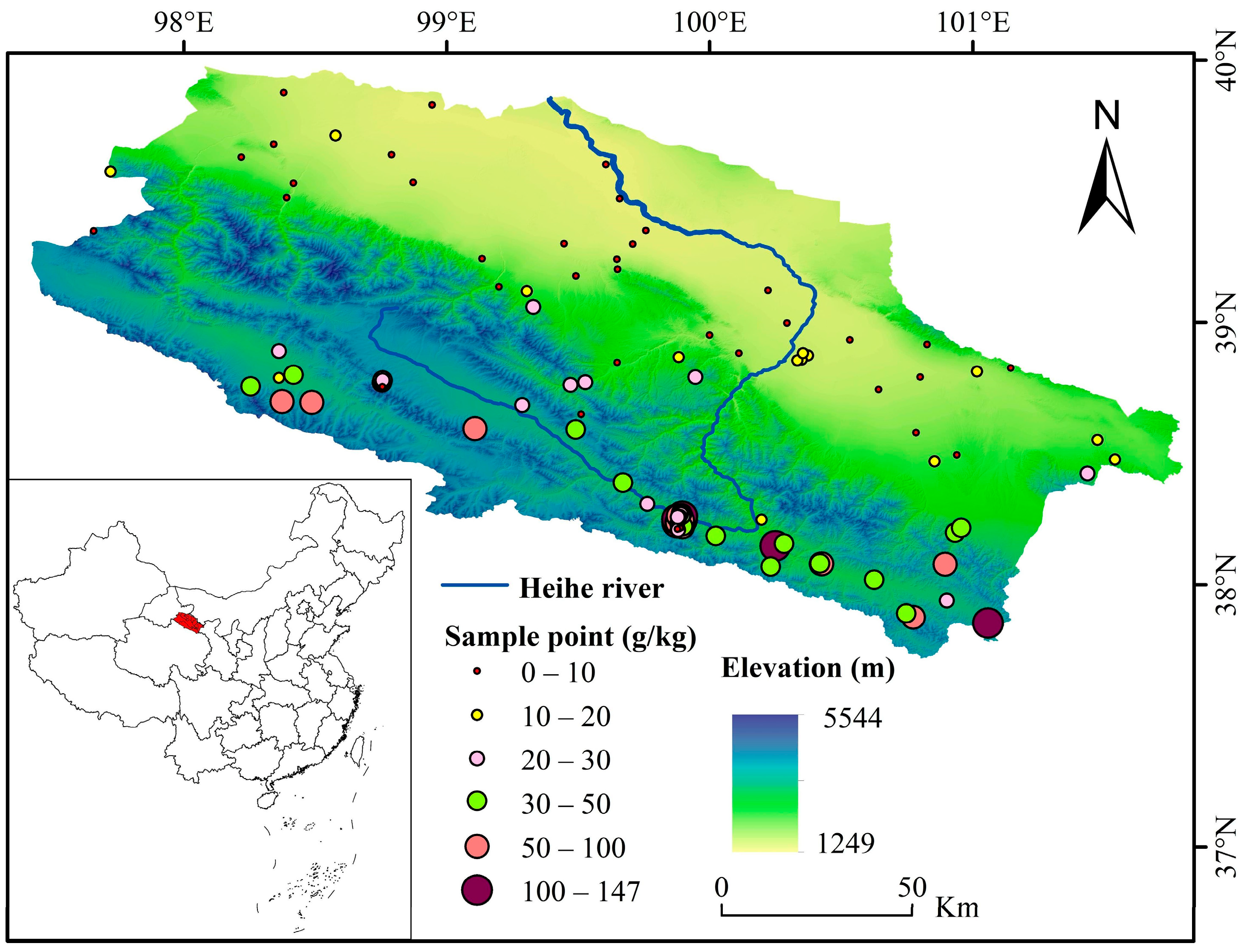

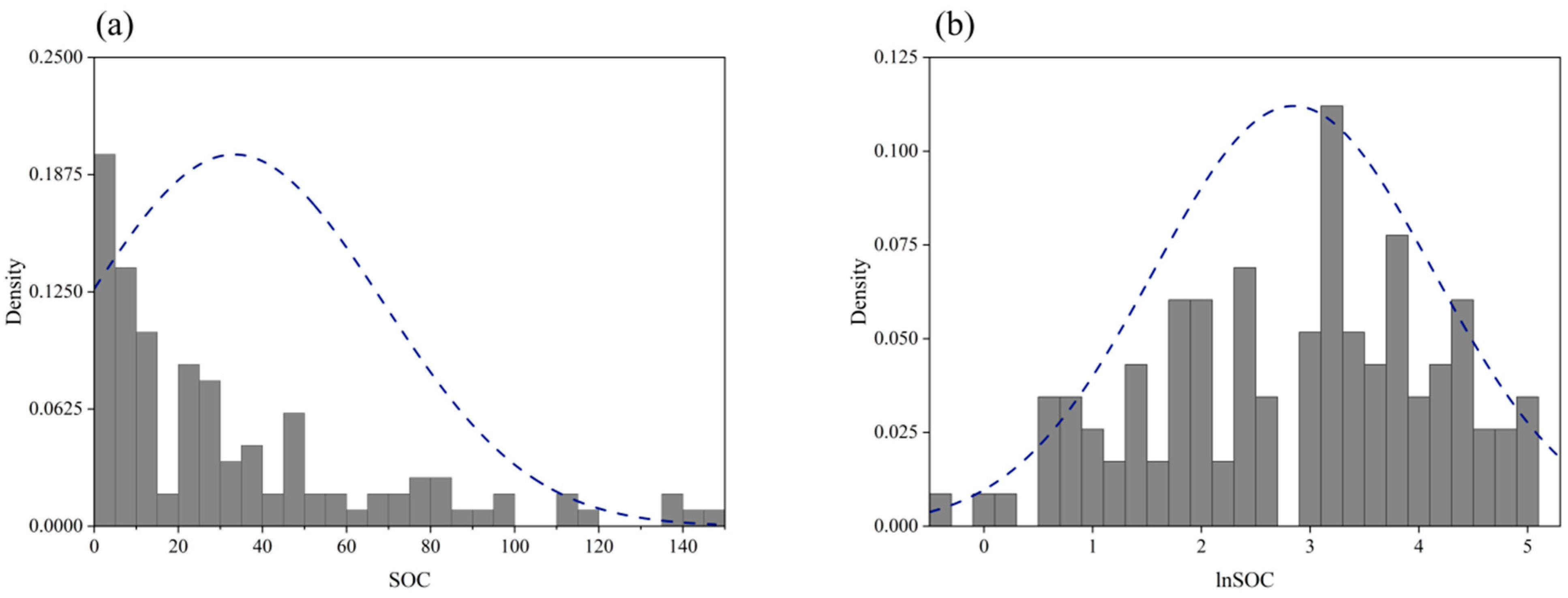
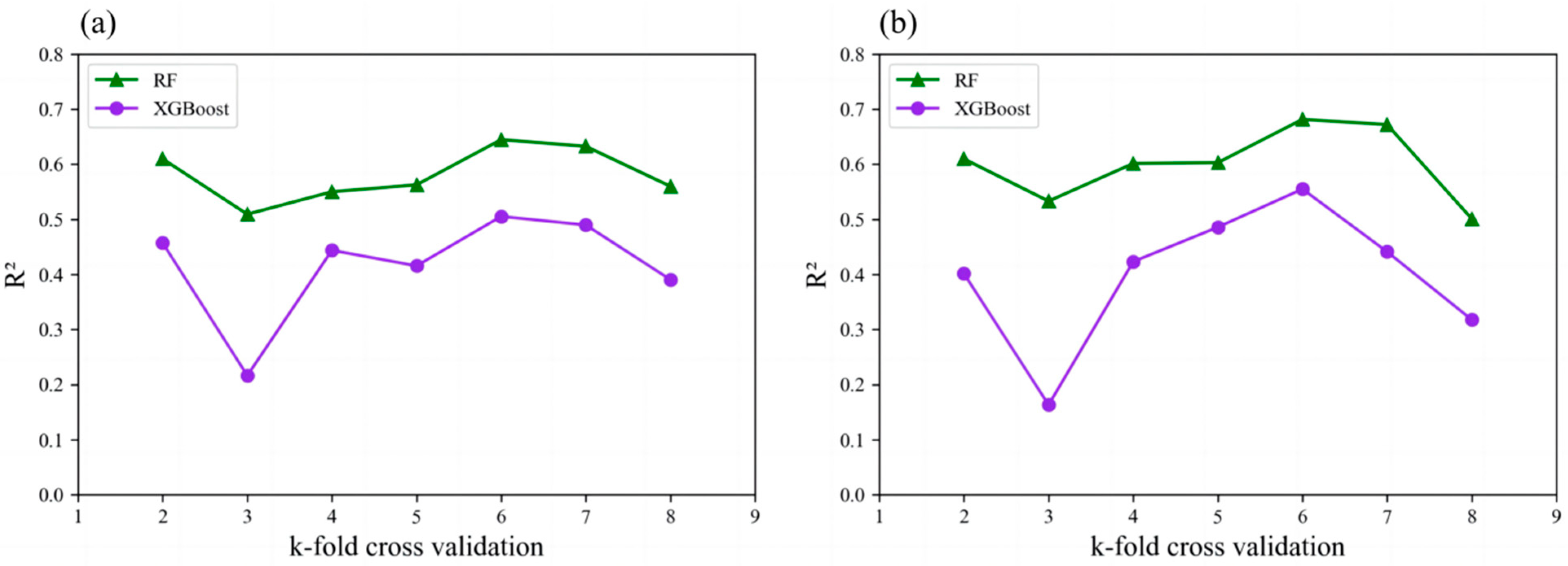

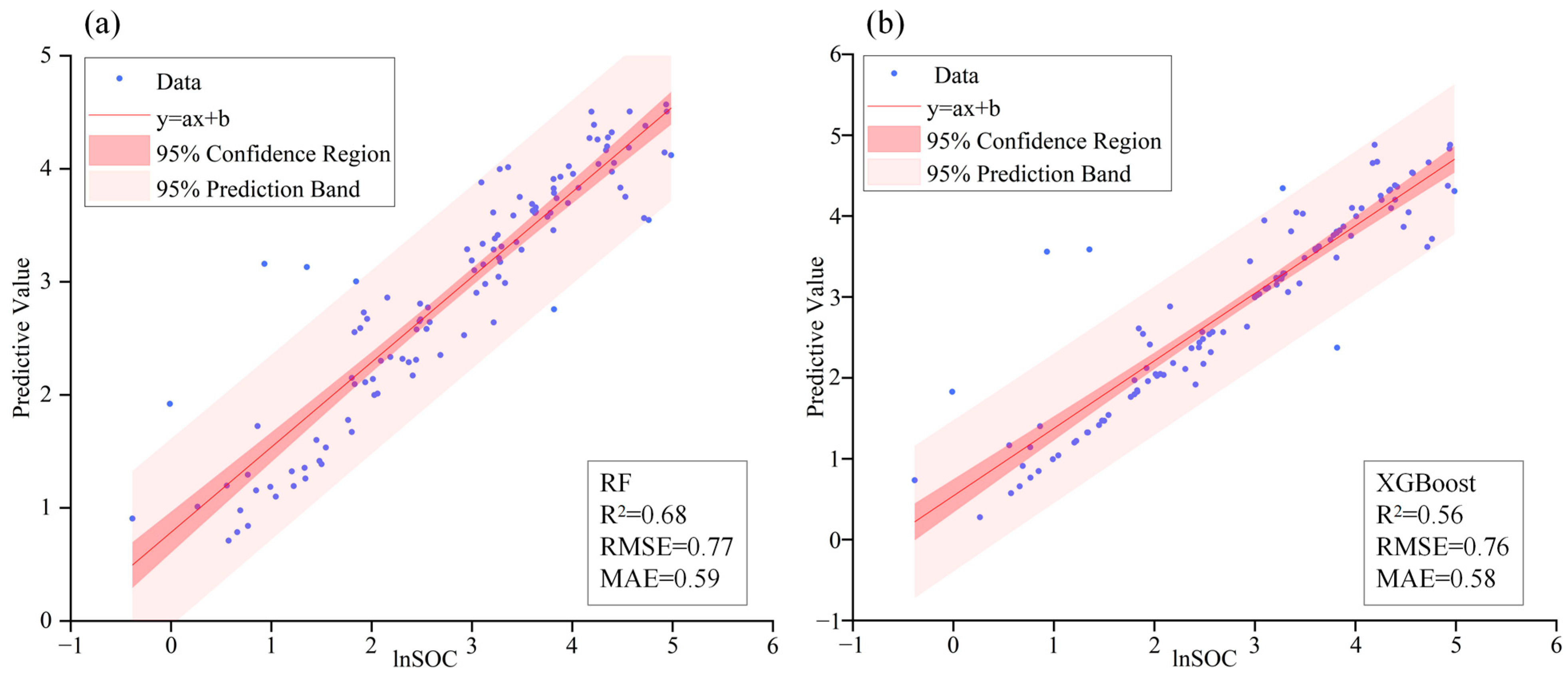


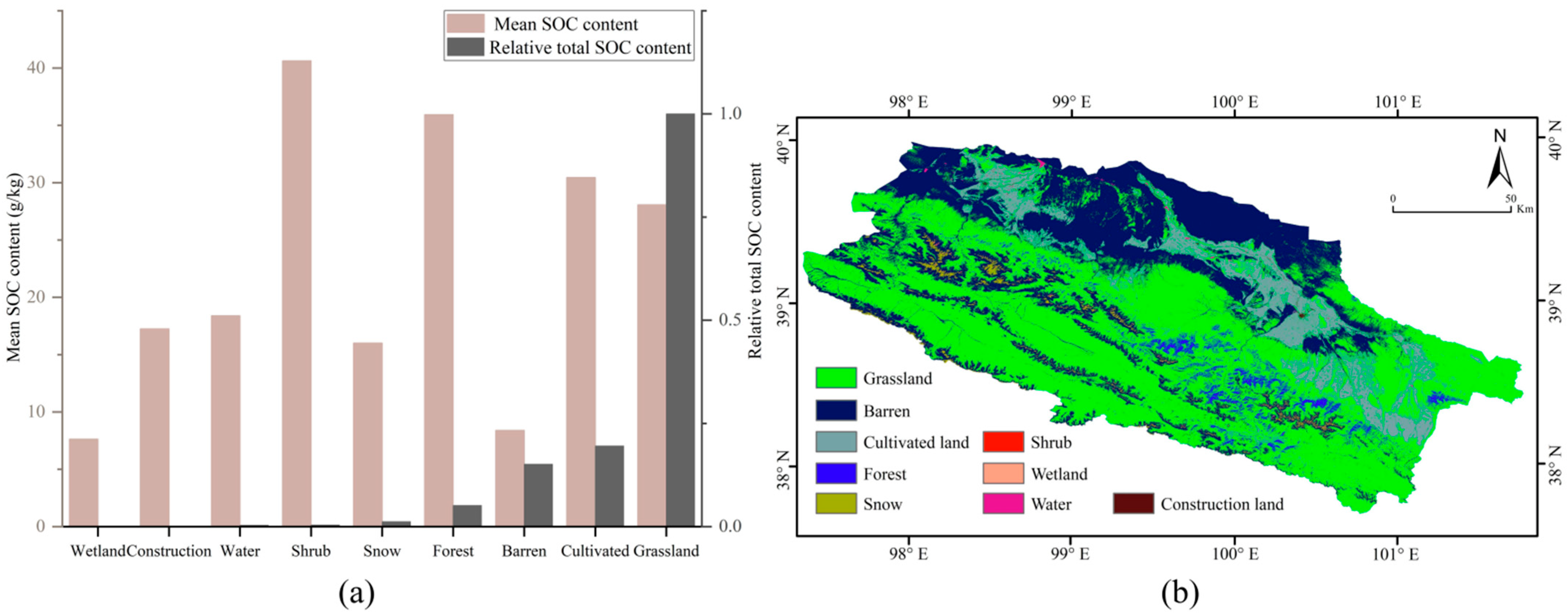
| Factor Category | Variables | Resolution | Time Period |
|---|---|---|---|
| Topography | Elevation Aspect Slope Catchment Area (CA) Topographic Wetness Index (TWI) | 90 m | - |
| Climate | Mean annual temperature (MAT) Mean annual precipitation (MAP) | 1000 m | 2010–2019 |
| Vegetation index | Normalized Difference Vegetation Index (NDVI) | 1000 m | 2010–2019 |
| Land use | Land use types | 30 m | - |
| Phenological variables | NumCycle Greenup MidGreenup Peak Maturity Senescence MidGreendown Dormancy EVI_Minimum EVI_Amplitude EVI_Area | 500 m | 2010–2013 |
| Minimum (g/kg) | Maximum (g/kg) | Mean (g/kg) | Standard Deviation (g/kg) | Coefficient of Variation (%) | Kurtosis (%) | Skewness (%) | |
|---|---|---|---|---|---|---|---|
| SOC | 0.31 | 146.27 | 28.33 | 33.65 | 1.19 | 2.48 | 1.71 |
| lnSOC | –1.17 | 4.98 | 2.59 | 1.33 | 0.51 | –0.69 | –0.17 |
Disclaimer/Publisher’s Note: The statements, opinions and data contained in all publications are solely those of the individual author(s) and contributor(s) and not of MDPI and/or the editor(s). MDPI and/or the editor(s) disclaim responsibility for any injury to people or property resulting from any ideas, methods, instructions or products referred to in the content. |
© 2023 by the authors. Licensee MDPI, Basel, Switzerland. This article is an open access article distributed under the terms and conditions of the Creative Commons Attribution (CC BY) license (https://creativecommons.org/licenses/by/4.0/).
Share and Cite
Liu, X.; Wang, J.; Song, X. Improving the Spatial Prediction of Soil Organic Carbon Content Using Phenological Factors: A Case Study in the Middle and Upper Reaches of Heihe River Basin, China. Remote Sens. 2023, 15, 1847. https://doi.org/10.3390/rs15071847
Liu X, Wang J, Song X. Improving the Spatial Prediction of Soil Organic Carbon Content Using Phenological Factors: A Case Study in the Middle and Upper Reaches of Heihe River Basin, China. Remote Sensing. 2023; 15(7):1847. https://doi.org/10.3390/rs15071847
Chicago/Turabian StyleLiu, Xinyu, Jian Wang, and Xiaodong Song. 2023. "Improving the Spatial Prediction of Soil Organic Carbon Content Using Phenological Factors: A Case Study in the Middle and Upper Reaches of Heihe River Basin, China" Remote Sensing 15, no. 7: 1847. https://doi.org/10.3390/rs15071847
APA StyleLiu, X., Wang, J., & Song, X. (2023). Improving the Spatial Prediction of Soil Organic Carbon Content Using Phenological Factors: A Case Study in the Middle and Upper Reaches of Heihe River Basin, China. Remote Sensing, 15(7), 1847. https://doi.org/10.3390/rs15071847





